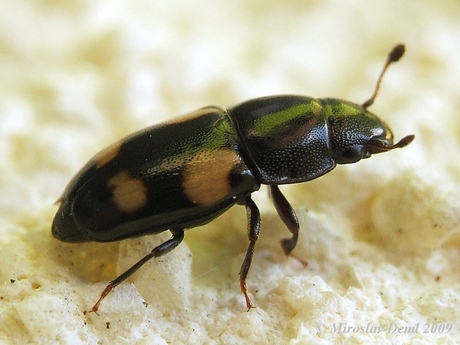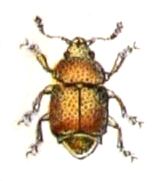Keepers of Poison Frogs, Mantellas, newly-transformed frogs, and other tiny amphibians face difficulties in providing their charges with a varied diet. Wild frogs consume dozens to hundreds of invertebrate species, but captives are usually limited to fruit flies, flour beetles, pinhead crickets and springtails. Vitamin/mineral supplements help, but dietary variety remains critical.
Throughout my career at the Bronx and Staten Island Zoos, I have relied heavily upon wild-caught invertebrates. I recently “re-discovered” an old favorite – the various Sap or Picnic Beetles (Family Nitidulidae). I first used Sap beetles when rearing Wood Frog metamorphs decades ago, and later fed them to Spring Peepers, Red-Eyed Treefrogs, Poison Frogs and others in zoo collections. Many small amphibians will eagerly gobble up Sap Beetles, but Poison Frog and Mantella keepers will find them especially useful. Sap Beetles never fail to bring an enthusiastic feeding response, and can save us some time and money while providing nutrients missing from standard foods.
Natural History
Sap Beetles are classified in the Family Nitidulidae, which contains nearly 3,000 members. Most top out at 1/8 inch, with the largest barely reaching ¼ inch in length. Several species, commonly known as “Picnic Beetles”, show up when sweet foods are served outdoors. Some feed upon over-ripe fruits, corn and other crops, while others take nectar, sap, fungi and carrion.
Sap Beetles are rather long-lived for such small insects, and most US natives hibernate as adults. Another distinguishing characteristic is the deeply-segmented antennae, which give the impression of a club (please see photo). Were it not for these unique antennae, I’d likely still be searching my field guides for hints, as those I trap are minute!
Collecting Sap Beetles
Sap Beetles are easy to trap in jars baited with over-ripe fruit. Banana and mango skins, strawberries and cherries all seem equally attractive. In my yard, Sap Beetles invariably arrive earlier than fruit flies, and in greater numbers. They also stay as long as the jar is in place – day or night.
I have not positively identified the species I have been using, but am leaning towards the Dusky Sap Beetle, Carpophilus lugubris, and the Strawberry Sap Beetle, Stelidota germinate. I plan to show some specimens to a friend in the entomology department at the American Museum of Natural History shortly.
Using Sap Beetles
I generally trap beetles in jars that will fit into my terrariums, so that I can merely open the tops at feeding time. I especially favor the small plastic containers in which garlic, basil and other spices are sold. These have a perforated inner top which keeps pets out while allowing beetles to exit.
Sap Beetles fly well, and can fit through the mesh on typical screen terrarium covers. When using them, I place an old towel over the terrarium top, and then secure the screen lid above. This effectively prevents escapes…I’m fond of beetles, but not in my morning fruit salad!
The tiny, yellowish larvae are also eagerly accepted by small frogs and salamanders. Earwigs, slugs and other beetles also appear in my fruit jars; these are fed to larger herps, spiders and fishes.
Keeping and Breeding
The beetles will live for quite some time in covered jars, but mold and fungus take hold rapidly. Extra beetle jars can be stored in a refrigerator…the species I collect tolerate 40 F.
Breeding and rearing seems feasible, as a mere 25-35 days elapse between hatching and adulthood. US natives produce 3-4 generations each summer. Fruit spoilage and mold would be concerns, however…perhaps jelly, or even fruit fly medium, would be workable (any experimenters out there?…please let me know).

Uploaded to Wikipedia Commons by M R G WIKI999
Wild Caught Insects: Pro and Cons
I’ve written a number of articles on the use of wild-caught invertebrates as herp food. From pit fall traps to the Zoo Med Bug Napper, there are many effective and enjoyable ways to collect food for your pets. I’m constantly finding species I’m not familiar with…even in habitats I’ve explored since childhood. Each season, I wind up keeping several insects or spiders that catch my interest. Care is needed, but the rewards are worthwhile. Collecting insects for bird and herp food was standard practice during my many years at the Bronx Zoo…please see the linked articles and post below for further information.
 That Reptile Blog – Reptile, Amphibian and Exotic Pet Care and Information
That Reptile Blog – Reptile, Amphibian and Exotic Pet Care and Information





Hello Frank,
This is very interesting. I recently took the leap into dendrobatid frogs because I wanted to get back into terrarium building. I currently keep ‘azureus’ and recently took a pair of Oophaga pumilio in trade. Bean beetles as you likely know have become very popular feeders…they are quite easy to keep and feed off but unfortunately seem to be better escape artists than fruitflies-I think i may phase them out as my roommates do not appreciate them. They are also generally speaking too big for the smaller dart frogs like pumilio-perfect for the larger ones though. These beetles seem like they could fill that gap. I think I will put out some smooshed fruit and see what happens.
Have you experimented with milkweed bugs at all?
~Joseph
Hi Joseph,
Nice to hear from you; hopefully there will be a small species nearby. I’ve not tried lab-raised milkweed bugs, but seems like a fine idea (wild caught would likely be rejected, or toxic). Leaf litter inverts, newly hatched mantids (may be too big for some), termites ideal. Termite trap: http://bit.ly/1cpcCs4
Fascinating! I would really like to try culturing these. I’m not sure they can be found in my area, but it’s worth a try. I’ve been very interested in finding alternative feeder invertebrates lately, so this is exciting news for me.
Hello Torin,
Thanks for the kind words. I’ve always used a variety of wild caught inverts in both zoos and my collection. This insect trap is useful for moths, midges, certain beetles. Following are links to other invert-collecting articles; please let me know what you think:
http://bit.ly/1cpcCs4
http://bit.ly/11eWsN4
http://blogs.thatpetplace.com/thatreptileblog/2009/05/11/collecting-live-food-for-reptiles-and-amphibians-an-entomologist%E2%80%99s-technique/
http://blogs.thatpetplace.com/thatreptileblog/2008/10/06/terrestrial-isopods-sowbugs-pillbugs-potato-bugs-as-food-for-captive-reptiles-and-amphibians/
http://blogs.thatpetplace.com/thatreptileblog/2012/03/16/live-food-care-reptile-amphibian-tarantula-and-scorpion-diets/
http://blogs.thatpetplace.com/thatreptileblog/2013/04/18/the-best-foods-for-poison-frogs-mantellas-and-other-tiny-amphibians/
Hi Frank, I really never blogged before so Im not sure Im doing this right.
Anyway, as I had discussed with you before I have two year old box turtles. One has grown rapidly and the other not so much. I have them both in a 20 gallon aqaurium with clean coconut soil, a few palnts and water. I have it located in kitchen by window so they get natural sun light during day and use a incandesent heat lamp at night. i believe i maintain a 75 to 80 deg temp for them. I feed them tetra reptomin softgel and zoo med hatching formula. i also grate carrots and give them crickets.
Hi Susan,
Thnaks for your comment nad update; if you can post future comments at this article, others more folks with similar interests will be able to view.
More space would be preferable; please see note in article re table top enclosures.
Glass filters-out all beneficial UVB, so they are not getting exposure through window. A good UVB florescent or mercury vapor bulb should be used.
Coconut husk tends to get soggy when sprayed daily (tank should be thoroughly misted each day, and bowl should be large enough for soaking) and sticks easily to food. I prefer various wood chips; a covering of dead leaves can be added.
Best to check temps with a thermometer; please see article for ambient and basking site recommendations.
Diet you describe is not ideal; please see article. Whole organisms, esp. pre-killed pink mice of available, and earthworms, are important. Crickets are fine as a treat but have a poor nutritional profile unless well-fed and supplemented. Freeze dried shrimp are also a good CA source (by mixing in mashed strawberries, you can induce box turtles to take most food items). I mix reptomin into all meals (not formulated for box turtles but very useful..part of most zoo diets) along with a pelleted as opposed to gel-type box turtle food.
Reptocal should be added to all meals; es impt if earthworms, pink mice are not used. ReptiVite with D3 or similar should be used 2-3 x weekly.
A much wider variety of fruits and vegetables should be offered; please see article for details.
Here is a related article that may be of interest: http://bit.ly/uhd9fw
Enjoy and pl let me know if you need further info, best, Frank
Thank you Frank for all the useful info. I will work on improving enviroment ASAP.
Thank you so much Frank. I will work on their enviroment ASAP.
My pleasure, Susaan,
Enjoy and pl let me know how all goes, Frank
Frank, another problem/question. I found one of my adult male box turtles with an ear abscess yesterday. He seems to be very active and eating but it looks horrible. First time in 11 years that
i have one of the adults with any problems. Most everyone says take it to vet but the guy I get
the turtles from in Vegas said I could do it myself. He said he does this just about everyday as they
get turtles brought in from the wild. He gave full instructions and it seems easy enough but I am
a bit scared. I do have a very steady hand but still. Have you ever done this procedure yourself?
Hi Susan,
Some box turtles seem very prone to ear abscesses…I’ve seen it often in both the zoo and field; some research suggests a link to overly-dry conditions, but that would not likely be true of yours.
I would not attempt treatment at home; the inner ear is a complicated structure; no way to physically remove all the pus etc that accumulates. Even were that possible, the underlying infection, usually bacterial, must be handled with antibiotics. Turtles in good health may battle the infection on their own, but risky. Your supplier seems lucky, or perhaps is just cleaning and releasing (and not aware that infections remain?). Please let me know if you need help in locating an experienced vet. Best, frank
I do know a local vet that works on reptiles. I will most likely take him in tomorrow as I had already made an appointment. I just knew I was not comfortable doing this myself and just wanted another
opinion. Thanks again. I’ll let you know how he does.
Typical infections respond well to treatment; any details from vet, re type of micro=organism involved, would be appreciated; very useful to keep track of such things. If possible, can you please future comments at this article; in this way, it’s more likely that readers with similar concerns will benefit from your experiences. Good luck, Frank